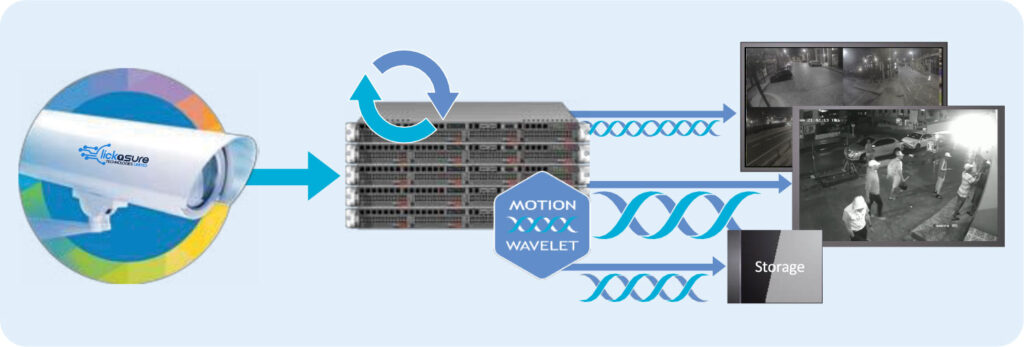Motion Wavelet is a wavelet conversion–based video codec developed by Clickasure and Stream Labs specially for security needs, using both interframe and intraframe compression. UsAe of Motion Wavelet makes video systems more efficient for several reasons:

- Compared to MJPEG, Motion Wavelet compresses video to a smaller size (thanks to interframe compression and highly advanced intraframe techniques), which reduces the cost of data storage and eases streaming requirements.
- Motion Wavelet does not have the high stability and bandwidth requirements of MPEG-4, which makes the codec more flexible and reliable for data transfer.
- Motion Wavelet has a smaller CPU footprint on workstations and video servers. It offers resource-efficient scaling of video resolution and frame dropping without needing to perform decompression. Put simply, the video stream sent to the client computer has exactly the resolution and frame rate needed for the current task, no more and no less. The server does not need to decompress the video before scaling it for client needs, and the client computer does not need to unpack a higher-than-needed resolution stream to make it fit on the screen.
Because the Motion Wavelet codec adapts so well to all sorts of bandwidth conditions as well as both slower and faster computer hardware, there is enormous flexibility in the network and hardware infrastructure sufficient for Intellect-powered systems.
NETWORKING
Intellect offers a wide range of network-centered options for video surveillance:
- Recorded video on a server can be transferred (in real time or according to a schedule) to dedicated archive servers for long-term storage.
- Each client can access the archives of a particular server, as well as archives on dedicated archive servers.
- Video streams can be channeled through the Videogate module, so that even as additional clients get video from a specific server, the bandwidth load on the server does not increase.
- Clients can get video streams from a server on a different network segment, thanks to Videogate.
- GreenStream technology allows dynamically choosing the video stream best suited for current viewing needs.
VIDEOGATE
Videogate is a software module for routing and pruning video streams. In other words, Videogate gets video from a server and streams it to multiple clients at the resolution and frame rate needed for each individual client. This avoids unneeded loads on the network and server, since wasteful duplication of video tasks is prevented.
With Videogate, clients have fully fledged access to video servers on different network segments, allowing creation of a multilevel network hierarchy for client–server connections. If a connection drops or bandwidth.
GREENSTREAM
GreenStream reduces use of bandwidth and workstation CPU cycles by sending only as much data as is needed for a given surveillance task. This technology dynamically selects which video stream to send to a remote computer, streaming the smallest one that has sufficient resolution for that user’s needs. And when the user displays the video at full screen, a higher-resolution stream is automatically selected.
REMOTE MONITORING
Intellect also supports remote video surveillance and control of pan/tilt/zoom (PTZ) cameras from a PC web browser or iOS mobile app.
One tool for effective audio recording is threshold levels: a particular audio channel is recorded only after the detected volume exceeds a certain level. Operators can adjust this level based on needs and site conditions, etc.
Audio can be enhanced for increased volume during playback. Hardware audio support is available through the video capture cards used in Intellect.
UNLIMITED MICROPHONES AND PHONE LINES
There is no limit on the total number of microphones and phone lines in a system. Any server can be connected to any number of phone lines the only limitation is the performance of the server itself.
SOFTWARE COMPRESSION
During recording, audio is compressed in real time. The user can select the compression level and audio quality that is most appropriate. Analog-to-digital conversion depends on the type of sound card and characteristics, with 8 to 96 kHz sample rates.
CONVENIENCE AND EASE OF USE
The Intellect interface for management of the audio subsystem has a standard player
interface. If video is recorded in sync with audio, both are played back automatically at the same time.
NETWORKING
The Intellect audio subsystem boasts all of the networking features available to other subsystems, including remote playback of recorded audio, remote configuration, and more.
INTEGRATION
The audio subsystem is highly integrated with security systems from other manufacturers, which allows configuring many types of reactions to audio signals, as well as a wide array of methods for passing audio alerts about securityrelated events.


